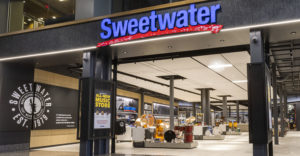
Earlier this week, the U.S. Supreme Court struck down some states’ regulations limiting out-of-state shipments of wine. The ruling could help spur some e-commerce sales of wine, at least among individual vineyards, which might gain the right to sell directly to individuals.
However, such sales are a small fraction of the overall market for wine, by most accounts less than 1 percent of the overall US$22 billion per year industry. Despite all the hype in the aftermath of the court ruling, Wine.com Chief Executive Officer George Garrick doesn’t expect much to change.
Still, there’s no denying that the coverage of the case has refocused attention on San Francisco-based Wine.com, an e-commerce firm that traces its roots back to the early days of the dot-com era.
Dot-Com Bust Survivor
Wine.com has a long and varied dot-com history, dating back to the peak of the Internet era. The company now known as Wine.com actually began as eVineyard.com and has outlasted virtually all of the competitors in what was once a crowded field.
Just hours after the ruling from the highest court in the land came down, Garrick spoke with the E-Commerce Times about why the decision in the case won’t substantially change Wine.com’s business in the short term, about how the company’s recent partnership with Amazon.com will help it grow by exposing it to new audiences, and about how Wine.com has survived while so many of its competitors and contemporaries fell by the wayside.
ECT: You’re on record as saying the Supreme Court ruling on out-of-state wine sales doesn’t fundamentally change things for you. Can you explain why?
Garrick: The ruling doesn’t really impact us. It was geared toward wineries, not retailers. The two are very different license types. The provisions of this law are for wineries, some of which were too small to get into stores. Some states had been discriminating by allowing in-state sales but not out-of-state sales over the Internet. The Supreme Court said they were still free to make whatever laws they want — but this is just about the wineries. Direct sales from wineries only account for about one-half of 1 percent of all sales. This is getting a lot of attention, and it might increase awareness of online wine sales, but at the end of the day, the impact is small.
ECT: So the ruling won’t change where and how you sell wine online?
Garrick: There are a number of states where we don’t sell or ship to, and often it’s because they’re just not large enough to justify setting up the distribution network. It’s really more for economic reasons than because of the specific regulations. We can ship into a number of states because they have reciprocity with California, which is good for the state because it produces so much wine. In other states, places like New Jersey and New York and Florida, they say in order for us to ship there we need a license. So we have gone and acquired them. Wineries are not allowed to hold retail licenses, so they had that extra layer of regulation to overcome.
ECT: Would you prefer to see a simpler approach, one that created a national standard?
Garrick: The current system is OK with us, and one of the big reasons why is that there’s really no other system that would work. If you think of any other product you buy — toothpaste or home electronics — you can’t go and buy directly from the manufacturer. There are usually several tiers of aggregation that products go through, from manufacturer to distributor to retailer to consumer. We’re perfectly happy to work within the system, and the fact that we’ve been working with it for a long time gives us an advantage. The work required to be in compliance with the system does serve as a barrier to entry for competitors.
ECT: Speaking of competitors, you have outlasted other online wine sales sites that were born during the dot-com era. Why?
Garrick: Part of it was the last-man-standing idea. Somebody had to be left standing. [The current Wine.com began as eVineyard and in 2001 bought the wine.com domain when the company by the same name went belly-up.] Of all the startups in the area, most were trying to go around the system. The model that survived — ours — was the one that complied with and worked within the system.
ECT: Why did the other startups think they could circumvent the rules?
Garrick: I can’t say what was going on inside their heads. But there was a period when the Internet was the Wild West. People thought that the whole intermediate tier of business was going to go away and that everybody would buy direct. The other thing was that wineries and some retailers tried to go around the system, but they found out that they could not get major labels. The wholesalers wouldn’t sell to them because they weren’t playing by the rules. They basically said, “If you try to go around us and sell direct, we’re not going to give you access to the major labels we control.” The result was a lot of retailers online carrying bottles that you never heard of, but if you wanted to get a Dom Perignon from them, you couldn’t get it.
ECT: Wine.com is a heavy user of Web analytics. What have you learned from studying the traffic to your site?
Garrick: We do quite a bit. We track our sales in real time, so a couple times a day, we’re taking a look at traffic at the site. We analyze our sales. Every day, we get a daily report from the day before, and we have a daily sales plan, so we know pretty quickly if we’re falling short of a plan [and] we can change something the next day. We also do quite a bit of survey work to find out what people like and don’t like. We’re a fairly information-intensive operation, but probably not that much different from a lot of other e-commerce companies in that regard. [Traffic data at wine.com also showed a substantial increase in traffic after the Supreme Court ruling was announced.]
ECT: You recently announced a partnership with e-tail giant Amazon.com. What was behind that move?
Garrick: It’s simple, really. We have developed a very unique distribution platform for selling wine over the Internet. But we’re a small company. We can’t reach millions of people. Amazon, on the other hand, has 30 or 40 million customers, but they can’t sell wine. They don’t have the legal distribution system. This makes it possible for Amazon to add wine sales to its site and makes it possible for us to possibly reach millions of new customers that we otherwise couldn’t.
ECT: Who are your customers and have they changed over the years?
Garrick: The awareness that people can buy wine online legally is still not that great. A lot of people still don’t know that. But if you look at the profile of people who buy on our site, they have a reasonably good knowledge of wine. Our target audience is a frequent wine buyer, but he’s not an expert or a collector. For that kind of frequent buyer, our site offers a convenient option. Our value proposition is convenience and selection. We’re competitive on price, but we’ve made a conscious decision not to make discount prices our main differentiator in the marketplace.
ECT: Wine drinking got a boost last year from the surprise success of the movie “Sideways.” Did you enjoy any benefits from that?
Garrick: We did see more traffic and more sales, but we put a number of promotions in place to take advantage of it, so it’s difficult to know how much was a direct result of the movie itself making people more interested in wine. We did some promotions on Pinot Noir and around the “Sideways” theme. There was more traffic on the site, but we were responsible for driving a lot of it there.
























































Social Media
See all Social Media